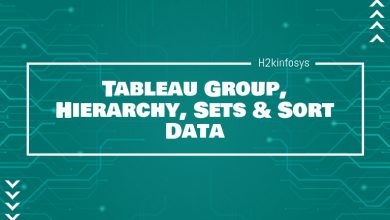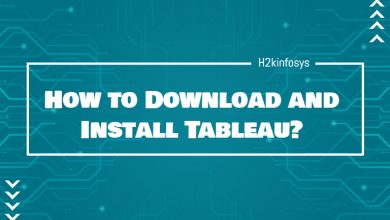Tableau Interview Questions and Answers

- What is Tableau?
Tableau is considered as a powerful data visualization tool used in Business Intelligence (BI) Industry, which simplifies the raw data into an easily understandable format.
- What are the features of Tableau?
The main features of Tableau are:
- Data Blending
- No need of technical knowledge
- Real-time analysis
- Drag and drop feature
- Shared Dashboards
- Explain the different Tableau products.
Here is a list of Tableau products:
- Tableau Desktop: It is a self-service business analytics tool that translates pictures of data into optimized queries.
- Tableau Server: It is enterprise-level software where you can publish a dashboard using Tableau Desktop and share it within the organization using Tableau Server.
- Tableau Online: It is a hosted version of Tableau Server.
- Tableau Reader: It is a free desktop application where you can open and view the visualizations.
- Tableau Public: It is free Tableau software where you can make visualizations but need to save in a workbook or worksheet in Tableau Server.
- Name the different data types in Tableau.
- Boolean
- Date
- Date & Time
- Text/String
- Number
- Geographical values
- Define Measures and Dimensions.
Measures are the numeric values or measurable quantity of data. Measures are stored in a table that supports data storage at atomic levels. For example, a Sales Table may consist of Product Key, Promo Offer, Items Sold, etc.
Dimensions are the descriptive value of an attribute. For example, product name, size, color, description, etc.
- What is the difference between a .twb and .twbx extension?
A .twb is the extension of an XML document that contains all the selections and layout made in the Tableau workbook, whereas a .twbx is the extension of a zipped archive.
- Name the types of join in Tableau.
- How many tables can you join in Tableau?
You can join 32 tables maximum in Tableau.
- What are the different ways of connections you can make with the dataset?
There are two ways to make a connection with your dataset:
- Live: You can connect live to the dataset.
- Extract: This method will make a static snapshot of the data to be used.
- Explain Shelves.
Shelves are available on the top and left of the view. Views can be build by placing field onto the shelves.
- Define Sets.
Sets are the fields that contain a subset of data based on some condition.
- Define groups.
Groups are a combination of Dimension members to make high-level categories.
- What is the Hierarchical field?
The hierarchical field is used for drilling down data, which means viewing the data in a more granular form.
- What is the Tableau Data Server?
Tableau server acts as a medium between Tableau users and the data. It allows you to upload and share extracts of data, maintain database connections, etc. You can make changes to the data set, calculate fields, save and share with others.
- What is the Tableau Data Engine?
Tableau Data Engine is an analytical database that is designed to achieve instant query response, predict performance. While working on the large amount of data, it may take some time to import the data, but after that, everything speeds up.
- Explain the types of filters in Tableau?
Filters are used to make restrictions on the data from the database. There are different filters in Tableau:
- Normal filter: It restricts the data based on the dimensions and measures.
- Quick filter: It is used to filter each worksheet on a dashboard while changing the values at run time dynamically.
- Context filter: Context filter is used to filter the data that is being transferred to the individual worksheet.
- How to create a calculated field in the Tableau?
Click the drop-down option to the right side of Dimensions on Data Panel and then select Create > Calculated field to open the calculator.
Name the field and write the formula.
- What is a dual-axis?
The dual-axis helps the users to view the scales of two measures in the same graph.
- What is the main difference between a tree map and a heat map?
A heat map is used to compare categories with color and size.
A tree map does the same, but the difference is it is most powerful and used for illustrating hierarchical data and part to whole relationships.
- What is aggregation and disaggregation of data?
Aggregation is the process of viewing numerical values or measures at a higher and more summarized level.
Disaggregation means the data allows viewing every row of your data, which is useful for analyzing measures.
- What is the difference between blending and joining in Tableau?
Blending means combining data from two different sources while joining means combining data from the same source.
- Define Extracts and Schedules.
Extracts are the first copy of actual data from original data sources but then do not refresh while publishing until a Schedule is applied to them.
Schedules are used to schedule tasks so that they refresh automatically while publishing. This removes the burden of republishing.
- How to view underlying SQL queries?
There are two ways to view the underlying SQL queries:
- Create a performance recording:
Help > Settings and Performance > Start Performance Recording
Help > Setting and Performance > Stop Performance Recording
- Reviewing the Tableau Desktop logs
- How to do performance testing in Tableau?
Performance testing can be done by loading Testing Tableau Server with the help of TabJolt, which is a load generator used to perform QA. TabJolt is not directly supported by Tableau; it needs to be installed from other sources.
- What are the components of a dashboard?
- Horizontal
- Vertical
- Text
- Image Extract
- Web [URL Action]
- How to remove All options from a Tableau auto-filter?
Click the down array in the auto-filter heading. Scroll down to Customize in the dropdown and uncheck the ‘Show All’ attribute.
- How to add custom color to Tableau?
Restart Tableau Desktop after saving .tps file. From the measures pane drag the option, you want to add color to Color. Select Edit colors. Select the palette drop-down list when a dialog box opens and customize as required.
- What is the TDE file?
TDE is a Tableau Desktop file containing .tde extension. It is a file that contains data extracted from external sources such as MS Excel or CSV file.
- Can you create relational joins in the Tableau without creating a new table?
Yes, we can create relational joins without creating a new table.
- How to automate reports?
Publish a report to Tableau server. You will find an option to schedule reports while publishing. Select the appropriate time when you want to refresh the data.
- What is Assume referential integrity?
Assume Referential Integrity is used to improve query performance. Tableau will only include the joined table in the query when its option is selected.
- Explain when you use blend vs. join.
When data is available in a single source, join is used. When data is not available in a single place, the blend is used.
- What is default Data blending join?
A default blend is the same as the left outer join and is used to bring data from multiple sources in a single Tableau view.
- What is a blended axis?
Blending multiple measures by dragging one measure or axis and dropping it on the other axis is called a blended axis.
- What is a story in Tableau?
A story is a sheet which is a collection of the sequence of worksheets or dashboards working together to convey information. Each individual sheet is called a story point.
- What is the difference between discrete data roles and continuous data roles?
Discrete data roles are the values that are distinct and can only take individual values in a range.
Continuous data roles are used to measure the continuous data, and it can take any value within an interval.
- How to create a story in Tableau?
Here are the steps to create a story:
- Click on the New Story tab.
- Choose a story on the lower-left corner of the screen.
- By default, the story gets its title from the sheet name. Double click on the title if you want to edit. Click Apply.
- Drag a sheet from the story tab and drop it at the center of the view.
- Click on Add a caption to summarize the story.
- To highlight a key, drag a text over the story worksheet and type your comment.
- What is the DRIVE program methodology?
It a methodology for scaling out self-service analytics. It relies on agile methods, iterative methods.
- How to use a group in a calculated field?
- Using groups in a collection.
- Blending data using groups created in the secondary data source.
- Use a group in another workbook.
- What is the main difference between the published data sources and the embedded data sources?
The published data source contains information that is independent of any workbook and can be used in multiple workbooks.
The embedded data source contains information that is associated with the workbook.
- Name the different Tableau files.
- Workbooks
- Bookmarks
- Packaged Workbooks
- Data Extraction Files
- Data Connection Files
- What is forecasting in Tableau?
Forecasting means to predict the future value of a measure.
- How to get the current date and time in Tableau?
Using the NOW() function.
- Explain the types of joins.
- Inner Join: It joins all the common records between two tables.
- Left Join: It is used to join all the records from a left table and common records from the right table.
- Right Join: It is used to join all the records from the right table and common records from the left table.
- Outer Join: It is used to join all the records from both the left and right tables.
- What is LOD Expression?
A LOD (Level of Detail) expression is used to run complicated queries.
- Mention various types of functions used in Tableau.
- String functions
- Logical functions
- Aggregate functions
- User functions
- Define the Histogram chart.
A histogram shows the values present in a measure and its frequency, showing the distribution of numerical data.
- Can Tableau be installed on macOS operating system?
Yes, Tableau can be installed on both the macOS and Windows operating systems.
- What are the advantages of Tableau over Excel?
- Tableau handles the problem of big data.
- Excel does not have large columns and rows.
- Excel has lesser resources as compared to Tableau.
- Explain alias in Tableau.
Alias is referred to as an alternative name that the user can assign to a member or a field.






One Comment